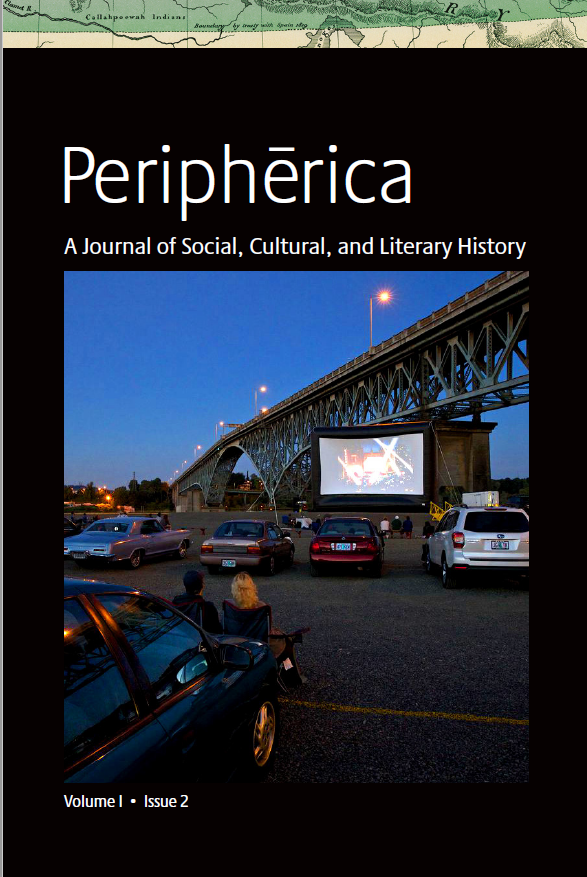From the Life to the Mind of the Writer in the Literary Biopic: Andrucha Waddington’s <i>Lope</i> and Ray Loriga’s <i>Teresa</i>
DOI:
https://doi.org/10.5399/uo/peripherica.1.2.13Abstract
Lope (Andrucha Waddington 2010) and Teresa (Ray Loriga 2007) have much in common. Both biopics center on a revered literary figure of the Spanish Golden Age. However, in spite of their many commonalities, these films embody two distinct tendencies in the contemporary literary biopic genre: one more “typical,” represented by Lope, that focuses heavily on plot development and another, represented by Teresa, that aspires to visually transpose to the screen aspects that relate to the main character’s interiority. Although Teresa has features of the “typical” contemporary literary biopic, it innovates the genre significantly by moving its focus from the life to the mind of the writer. Loriga uses the language of cinematography to depict the imagery and affective qualities of the mysticism of Teresa de Ávila—the force behind her writings—, creating a film that emphasizes image and emotions over plot. Teresa thus brings a different sensitivity to the literary biopic, which deviates from more formulaic films. Centering on the author’s mind can indeed be a new path for filmmakers to innovate the biopic genre, particularly in its literary strand. Finally, these two biopics illustrate the need to expand the scholarly conversation about the contemporary literary biopic genre, as they both engage with and deviate from the formula established by Anglo-Saxon biopics.References
ARTELOPE: Base de datos y argumentos del teatro de Lope de Vega. http://artelope.uv.es/basededatos/ Accessed 3 Aug. 2020.
Bingham, Dennis. “The Lives and Times of the Biopic.” A Companion to the Historical Film. Ed. Robert A. Rosenstone and Constantin Parvulescu. Oxford: Wiley-Blackwell, 2013. 233-54.
Bingham, Dennis. Whose Lives Are They Anyway? The Biopic As Contemporary Film Genre. Piscataway: Rutgers UP, 2010.
Buchanan, Judith, ed. The Writer on Film: Screening the Literary Authorship. New York: Palgrave, 2013.
Carmona, Alba. Las reescrituras fílmicas de la comedia nueva: Un siglo en la gran pantalla. Peter Lang, 2019.
Crespo Steinke, Carolin. “Travelling through the Centuries: The Intertextual Relationship between Shakespeare in Love, Molière and Young Goethe in Love.” English Text Construction, vol. 10, no. 1, 2017, pp. 59-77.
Custen, George Frederick. Bio/pics: How Hollywood Constructed Public History. New Brunswick: Rutgers UP, 1992.
Faulkner, Sally. A History of Spanish Film: Cinema and Society, 1910-2010. London: Bloomsbury, 2013.
García-Sánchez, M. Soraya. “Teresa, the Erotic Saint? A Journey to Paz Vega’s Acting in Theresa: The Body of Christ.” The Erotic in Context, edited by M. Soraya García-Sánchez, Cara Judea Alhadeff and Joel Kuennen, Inter-Disciplinary P, 2011, pp. 109-116.
Higson, Andrew. “Brit-lit Biopics, 1990-2010.” The Writer on Film: Screening the Literary Authorship. Ed. Judith Buchanan. Palgrave, 2013, pp. 106-20.
Higson, Andrew. English Heritage, English Cinema: Costume Drama since 1980. Oxford UP, 2003.
Lope. Dir. Andrucha Waddington. Perf. Alberto Ammann, Leonor Watling, and Pilar López de Ayala. Twentieth Century Fox Home, 2010. Film.
Lupo, Jonathan, and Carolyn Anderson. “Off-Hollywood Lives: Irony and Its Discontents in the Contemporary Biopic.” Journal of Popular Film and Television, vol. 36, no. 2, 2008, pp. 102-112.
Martín-Pérez, Celia. “A Woman for All Seasons: Teresa of Ávila on Spanish Screens.” Seeing in Spanish: From Don Quixote to Daddy Yankee — 22 Essays on Hispanic Visual Cultures. Ed. Ryan Prout and Tilmann Altenberg. Newcastle upon Tyne: Cambridge Scholars, 2011. 18-31.
Morley, S. Griswold, and Courtney Bruerton. “How Many Comedias Did Lope de Vega Write?” Hispania, vol. 19, no. 2, 1936, pp. 217-234. JSTOR, http://doi.org/10.2307/332239 Accessed 3 Aug. 2020.
“The Outlaw (2010).” Box Office Mojo, http://www.boxofficemojo.com/title/tt1186357/?ref_=bo_tt_ti Accessed 1 Aug. 2020.
Rosenstone, Robert A. History on Film/Film on History. Harlow, UK: Pearson, 2012.
Saint Teresa of Avila. The Complete Works of St. Teresa of Avila: Vol. 1. Translated and edited by E. Allison Peers, Burns & Oates, 2002. ProQuest Ebook Central.
Saint Teresa of Avila. The Complete Works of St. Teresa of Avila: Vol. 3. Translated and edited by E. Allison Peers, Burns & Oates, 2002. ProQuest Ebook Central.
Santa Teresa de Ávila. Escritos de Santa Teresa, añadidos é ilustrados por don Vicente de la Fuente, tomo I, Madrid, M. Rivadeneyra, 1861.
Shachar, Hila. “Authorial Histories: The Historical Film and the Literary Biopic.” A Companion to the Historical Film. Ed. Robert A. Rosenstone and Constantin Parvulescu. Hoboken: Wiley-Blackwell, 2013. 199-218.
Shachar, Hila. Screening the Author: The Literary Biopic. Palgrave Macmillan, 2019.
Smith, Greg M. Film Structure and the Emotion System. Cambridge UP, 2003.
Teresa, el cuerpo de Cristo [Theresa, the body of Christ]. Dir. Ray Loriga. Perf. Paz Vega, Leonor Watling, and Geraldine Chaplin. S.A.V., 2007.
“Theresa: The Body of Christ (2007).” Box Office Mojo, http://www.boxofficemojo.com/title/tt0458500/?ref_=bo_tt_ti Accessed 1 Aug. 2020.
“Theresa: The Body of Christ (2007).” IMDb, http://www.imdb.com/title/tt0458500/ Accessed 1 Aug. 2020.
Waddington, Andrucha. “Andrucha Waddington escribe sobre la experiencia de dirigir Lope.” Noticine.com, http://noticine.com/iberoamerica/36-iberoamerica/11495-andrucha-waddington-escribe-sobre-la-experiencia-de-dirigir-qlopeq.html Accessed 3 Aug. 2020.
Wheeler, Duncan. “Back to the Future: Repackaging Spain’s Troublesome Past for Local and Global Audiences.” (Re)viewing Creative, Critical and Commercial Practices in Contemporary Spanish Cinema, edited by Duncan Wheeler and Fernando Canet, Intellect, 2014, pp. 205-233.



